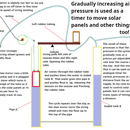Introduction: Make a Parabolic Solar Dish From an 8 by 4 Sheet of Plastic (without Too Much Waste)
I need to make a half parabolic dish for a solar cooking project and I am trying the "cone method" . Basically my dish will be made from concentric cones to mimic a parabolic dish and to give the desired concentration of light. For me a 6 inch ball of fire at the focus should work.
I am cheap and lazy so I want to get maximum use from an 8 by 4 sheet of plastic without having to cut it into a thousand petals and still have it work with the rest of the design.
What I came up with will probably work for me.
But I wanted to share the method so that it can work for you, and perhaps for disaster relief too.
Brian
Step 1: Design of the Parabolic Curve
I did this with an improvised t-square and basic technical drawing tools,wrinkled paper. and a calculator. So there are probably Measurement errors a plenty.
However the method is valid.
I will leave the image notes to explain things for the moment.
I start with the mirror straight across from the target ball because if you start anywhere else, it is hard to figure out how big your dish will be.
There are 2 ways to do the mirror angle.
The mirror is set up at half the angle of the light hitting the mirror and the light bouncing away from the mirror. The parallel lines method is much quicker than measuring angles but you need to check as errors creep in.
I never learned cad.
I am sure this will be perfected on computer aided design programs.
Step 2:
I cut out my concentric cones on a sheet of corrugated plastic and then had to glue the mylar on. I used wheat paste . I simply laid the sheet of mylar over the sheet of corrugated plastic and it stuck. Later, I used a knife to simply cut the mylar to the same patern as the sheet of corrugated plastic. It was easy!
Step 3: Keeping the Shape? How to Do It?
When I made the dish and taped it together it was still "floppy" and first I used duct tape and packing tape to keep the sections together. But they gradually slipped so after a few days there were gaps. Next i tried strips of plastic from a paint can and it worked. I drilled one inch screws through them into the corrugated plastic. But it still had looseness. I then added bamboo and this cured most of it and kept it rigid. Next time I will plan in the bamboo from the start.
Step 4: The Completed Half Dish
This half dish is big! About 1.6 or 1.7 sq meters of collector area. It consists of 6 cones cut from a sheet of corrugated plastic and remaining joined together.
More pictures of the process to follow soon. I think that spills from the pot will not affect the dish much because the dish is not underneath the pot. The pot is painted black and has a glass top.
Step 5: Mistakes Made and Lessons Learned
I made this completely from scratch and the objective was to learn while making the most effective use of the 8 by 4 sheet of material.
In the past I have used wheat paste with success on cardboard with foil or mylar. But if you put it between mylar and corrugated plastic, it takes forever to dry. Mine went moldy before it dried. So another glue is required.
I am not happy with mylar. You must face the metalized side up towards the sun or it will corrode by reacting with the glue. (Perhaps 2 layers of mylar one on top of the other with the metalized sides pressed against each other would work better? And then just held on with pins? or something similar?
I plan to make another reflector and use aluminium foil as the reflector material in it. And compare them.
Maybe 1/4 size models would not be expensive to make?
If I can find someone in Victoria with an interest in this (and some spare time) maybe we can test the thing.
The bamboo. I added it as an afterthought. But because of the parabolic shape you could have the bamboo or plastic or metal tubing all cut to size with holes ready to join them to the corrugated plastic. It could really work well!
The 3 point linkage. I just welded an extra piece of metal to the chair leg. But it would better be put in an optimized position.
I will write in more mistakes later.
The next stage is to put it on equatorial mount and align the mount properly.













